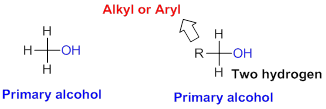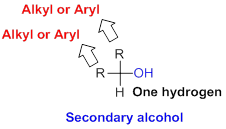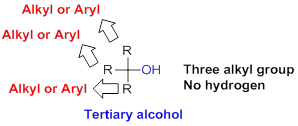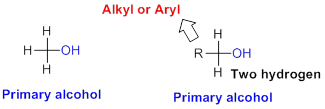
Concept explainers
(a)
Interpretation:
The alcohol should be identified as primary, secondary or tertiary alcohol.
Concept introduction:
Classification of alcohol:
Alcohols can be classified in to three types,
Primary,
Secondary,
Tertiary
Primary alcohol:
Hydroxyl group (

Secondary alcohol:
Hydroxyl group (

Tertiary alcohol:
Hydroxyl group (

(b)
Interpretation:
The alcohol should be identified as primary, secondary or tertiary alcohol.
Concept Introduction:
Classification of alcohol:
Alcohols can be classified in to three types,
Primary,
Secondary,
Tertiary
Primary alcohol:
Hydroxyl group (

Secondary alcohol:
Hydroxyl group (

Tertiary alcohol:
Hydroxyl group (

(c)
Interpretation:
The alcohol should be identified as primary, secondary or tertiary alcohol.
Concept Introduction:
Classification of alcohol:
Alcohols can be classified in to three types,
Primary,
Secondary,
Tertiary
Primary alcohol:
Hydroxyl group (

Secondary alcohol:
Hydroxyl group (

Tertiary alcohol:
Hydroxyl group (

(d)
Interpretation:
The alcohol should be identified as primary, secondary or tertiary alcohol.
Concept Introduction:
Classification of alcohol:
Alcohols can be classified in to three types,
Primary,
Secondary,
Tertiary
Primary alcohol:
Hydroxyl group (

Secondary alcohol:
Hydroxyl group (

Tertiary alcohol:
Hydroxyl group (

(e)
Interpretation:
The alcohol should be identified as primary, secondary or tertiary alcohol.
Concept introduction:
Classification of alcohol:
Alcohols can be classified in to three types,
Primary,
Secondary,
Tertiary
Primary alcohol:
Hydroxyl group (

Secondary alcohol:
Hydroxyl group (

Tertiary alcohol:
Hydroxyl group (

(f)
Interpretation:
The alcohol should be identified as primary, secondary or tertiary alcohol.
Concept introduction:
Classification of alcohol:
Alcohols can be classified in to three types,
Primary,
Secondary,
Tertiary
Primary alcohol:
Hydroxyl group (

Secondary alcohol:
Hydroxyl group (

Tertiary alcohol:
Hydroxyl group (

(g)
Interpretation:
The alcohol should be identified as primary, secondary or tertiary alcohol.
Concept introduction:
Classification of alcohol:
Alcohols can be classified in to three types,
Primary,
Secondary,
Tertiary
Primary alcohol:
Hydroxyl group (

Secondary alcohol:
Hydroxyl group (

Tertiary alcohol:
Hydroxyl group (

(h)
Interpretation:
The alcohol should be identified as primary, secondary or tertiary alcohol.
Concept introduction:
Classification of alcohol:
Alcohols can be classified in to three types,
Primary,
Secondary,
Tertiary
Primary alcohol:
Hydroxyl group (

Secondary alcohol:
Hydroxyl group (

Tertiary alcohol:
Hydroxyl group (

(i)
Interpretation:
The alcohol should be identified as primary, secondary or tertiary alcohol.
Concept introduction:
Classification of alcohol:
Alcohols can be classified in to three types,
Primary,
Secondary,
Tertiary
Primary alcohol:
Hydroxyl group (

Secondary alcohol:
Hydroxyl group (

Tertiary alcohol:
Hydroxyl group (

Want to see the full answer?
Check out a sample textbook solution
Chapter 14 Solutions
Fundamentals of General, Organic, and Biological Chemistry, Books a la Carte Plus Mastering Chemistry with Pearson eText -- Access Card Package (8th Edition)
- Calculate pH of a solution prepared by dissolving 1.60g of sodium acetate, in 88.5 mL of 0.10 M acetic acid. Assume the volume change upon dissolving the sodium acetate is negligible. Ka is 1.75 x 10^-5arrow_forwardShow a mechanism that leads to the opening of the ring below under acid-catalyzed conditions. Give the correct Fischer projection for this sugar.arrow_forwardWhat is the stereochemical relationship between B & C?arrow_forward
- Don't use ai or any chat gpt will dislike okk just use accurate information okkk okkk just solve full accurate. don't use guidelines okk just did it accurate 100% sure experts solve it correct complete solutions okkk follow all instructions requirements okkkarrow_forwardhow would you make this plot in excel?arrow_forwardwhat is the productarrow_forward
- Balance the following equation and list of coefficients in order from left to right. SF4+H2O+—-> H2SO3+HFarrow_forwardProblem 15 of 15 Submit Using the following reaction data points, construct Lineweaver-Burk plots for an enzyme with and without an inhibitor by dragging the points to their relevant coordinates on the graph and drawing a line of best fit. Using the information from this plot, determine the type of inhibitor present. 1 mM-1 1 s mM -1 [S]' V' with 10 μg per 20 54 10 36 20 5 27 2.5 23 1.25 20 Answer: |||arrow_forward12:33 CO Problem 4 of 15 4G 54% Done On the following Lineweaver-Burk -1 plot, identify the by dragging the Km point to the appropriate value. 1/V 40 35- 30- 25 20 15 10- T Км -15 10 -5 0 5 ||| 10 15 №20 25 25 30 1/[S] Г powered by desmosarrow_forward
- Essentials of Pharmacology for Health ProfessionsNursingISBN:9781305441620Author:WOODROWPublisher:Cengage
 Principles Of Radiographic Imaging: An Art And A ...Health & NutritionISBN:9781337711067Author:Richard R. Carlton, Arlene M. Adler, Vesna BalacPublisher:Cengage Learning
Principles Of Radiographic Imaging: An Art And A ...Health & NutritionISBN:9781337711067Author:Richard R. Carlton, Arlene M. Adler, Vesna BalacPublisher:Cengage Learning  Human Physiology: From Cells to Systems (MindTap ...BiologyISBN:9781285866932Author:Lauralee SherwoodPublisher:Cengage Learning
Human Physiology: From Cells to Systems (MindTap ...BiologyISBN:9781285866932Author:Lauralee SherwoodPublisher:Cengage Learning





